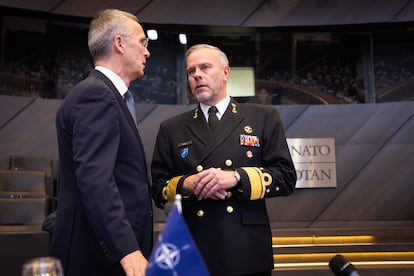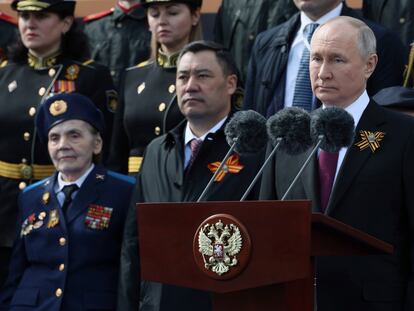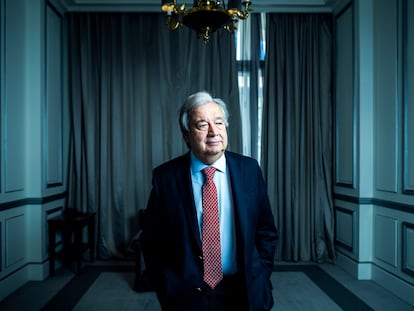NATO draws up biggest military reform since the Cold War to meet Russian threat
The Atlantic Alliance is expected to approve the new strategy, a response to the new geopolitical reality after Moscow’s invasion of Ukraine, at its Vilnius summit in July


Against the backdrop of Russia’s war in Ukraine and escalating rhetoric against the West from the Kremlin, NATO is finalizing the reform of a common strategy to tackle both the Russian threat and terrorist groups. Its structure, designed to respond the new geopolitical reality and accelerated by Moscow’s invasion, is “the biggest reconfiguration since the Cold War,” NATO sources told EL PAÍS.
The document, which runs to some 4,000 pages, outlines the first complete and unified reform of NATO doctrine in three decades. Among the proposals are changes to the Alliance’s military strategy — moving away from large-scale interventions to prioritize the deployment of smaller battalions and regional experts — and its methods to analyze and provide updates on the various threats posed by the Kremlin, among them military, cyber and hybrid attacks, and NATO’s response to these scenarios.
The military leaders of NATO’s 31 member states and Atlantic Alliance experts are now reviewing the strategy, which unifies national and regional plans. This reform is expected to be approved at the NATO summit in Vilnius in July, where the main items on the agenda will be the Russian invasion of Ukraine and the commitments the Alliance can offer Kyiv, which formally applied for membership last September.
“Allies will know exactly what forces and capabilities are needed, including where, what and how to deploy,” NATO Secretary General Jens Stoltenberg said Wednesday at a meeting with NATO military chiefs in Brussels, where the new package of proposals was discussed. “The Regional Plans will require an improved NATO Force Model to produce more troops at high readiness across our Alliance,” added Lieutenant-Admiral Rob Bauer, chair of the NATO Military Committee.
New NATO capabilities
With all eyes on movements on the front lines in Ukraine, NATO is pressing forward with its updated, geographically specific defense plans, which outline how the Alliance can respond to attacks against member states and how it will operate in the face of the Russian threat and global terrorism. The strategy also provides guidelines for the defense of key locations. “For the first time since the end of the Cold War, we will have objective, threat-based capability targets,” Bauer said.
Almost since its inception, NATO has had plans in place to address the potential threat of Russia: in fact, the Alliance was born an organization vis-à-vis the USSR. But Moscow’s invasion of Ukraine has drastically changed NATO’s relationship with the Kremlin, which for many years included high-level diplomatic ties and a bilateral cooperation council. The new strategy will operate on different levels: nationally, the so-called “strategic hat” that covers three large geographical areas (North Atlantic, Central Europe and the South, from Spain to Turkey), will provide detailed analysis of threats and possible reactions categorized by domain: land, sea, air, space, and cyberspace.
A range of threats
The threats facing NATO and potential scenarios are diverse: from the possibility of Russia deploying thousands of troops on the borders of the Alliance’s eastern flank to the vulnerabilities of the infrastructures of member states brought into focus by the attack on the Nord Stream gas pipelines, which has prompted the Alliance to step up surveillance of marine telecommunications cables, gas pipelines and other elements crucial to the operations of NATO members.
The last NATO summit, held in June last year in Madrid, declared the Russian Federation the “most significant and direct threat to Allies’ security and to peace and stability in the Euro-Atlantic area” and called for significant defense reinforcement, accelerating the development of the Regional Plans. In the new scheme, the focus is no longer only on strengthening NATO’s eastern flank, but on the need to establish a solid defensive network based on the so-called “360-degree approach” — one that covers NATO’s entire territory. The new strategy, for example, aims to reduce reliance on the deployment of numerous combat groups and instead to use brigade-sized units (made up of about 5,000 military personnel) that can move without fixed structures and deploy more rapidly, with vehicles, tanks and fighters pre-positioned on the ground.
The new concept has, however, unsettled NATO’s eastern European allies, who are on Russia’s doorstep. These nations are concerned that the plans represent too theoretical a framework and are calling for more concrete elements, as well as further strengthening the Alliance’s presence on their own flank. For the new strategy to be put in place, the Alliance will need more investment, according to sources within the organization.
On Wednesday, Stoltenberg once again stressed that NATO members must increase their defense spending. His goal is to agree on a new commitment, which is now at 2% of GDP “as a minimum.” However, although some countries including Canada have ramped up their defense budgets, others are barely at above 1% of GDP — Spain is at 1.09% and Belgium at 1.18%, for example — and states are not obliged to reach the 2% target. Spain has set itself the goal of reaching 2% by 2029 but is also pushing for contributions to the Alliance not to be measured only in terms of defense investment, but by military deployments and other factors.
The meeting of NATO military chiefs in Brussels coincided with mounting tension in Ukraine. The commander-in-chief of the Armed Forces of Ukraine, Valerii Zaluzhnyi, was unable to participate by videoconference, citing the situation on the front lines. Kyiv’s forces are preparing for a counteroffensive on the eastern and southern front while the Kremlin has launched a new wave of attacks on civilian infrastructure designed to wear down Ukraine’s air defense systems. On Wednesday, the Ukrainian Army said it had regained control of an area of several kilometers around the town of Bakhmut, the epicenter of Russian operations in Ukraine and where the mercenary Wagner Group has been complaining about a lack of ammunition supply for its troops.
Sign up for our weekly newsletter to get more English-language news coverage from EL PAÍS USA Edition
Tu suscripción se está usando en otro dispositivo
¿Quieres añadir otro usuario a tu suscripción?
Si continúas leyendo en este dispositivo, no se podrá leer en el otro.
FlechaTu suscripción se está usando en otro dispositivo y solo puedes acceder a EL PAÍS desde un dispositivo a la vez.
Si quieres compartir tu cuenta, cambia tu suscripción a la modalidad Premium, así podrás añadir otro usuario. Cada uno accederá con su propia cuenta de email, lo que os permitirá personalizar vuestra experiencia en EL PAÍS.
¿Tienes una suscripción de empresa? Accede aquí para contratar más cuentas.
En el caso de no saber quién está usando tu cuenta, te recomendamos cambiar tu contraseña aquí.
Si decides continuar compartiendo tu cuenta, este mensaje se mostrará en tu dispositivo y en el de la otra persona que está usando tu cuenta de forma indefinida, afectando a tu experiencia de lectura. Puedes consultar aquí los términos y condiciones de la suscripción digital.
More information
Archived In
Últimas noticias
Most viewed
- David King, chemist: ‘There are scientists studying how to cool the planet; nobody should stop these experiments from happening’
- Reinhard Genzel, Nobel laureate in physics: ‘One-minute videos will never give you the truth’
- Mexico completes its trade shift with the entry into force of tariffs on China and countries without trade agreements
- Oona Chaplin: ‘I told James Cameron that I was living in a treehouse and starting a permaculture project with a friend’
- Sinaloa Cartel war is taking its toll on Los Chapitos










































